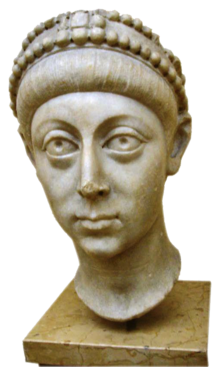Wreaths and crowns in antiquity


In
From
Wreaths of leaves from
Function

As can be inferred from Apuleius's The Golden Ass and Aristophanes's Plutus, to wear a wreath was a sign of distinction, and an assault on a wreath's wearer was considered especially blameworthy.[1][2][3] According to Tertullian's De corona, the wearing of wreaths was an ancient practice.[1][4] Indeed, it was rare for religious rites and cult practices to omit the wearing of wreaths.[5] Priests wore wreaths for the performance of sacrifices, as did other participants in the ceremony and the sacrificial victim.[1] Similarly, altars, statues, and religious buildings and accoutrements could all be wreathed.[1] Wreaths were sacred objects, and removing one and disposing of it could not be done casually or without due reverence, neither could an unauthorized person wear one without committing sacrilege.[1][6][7]
Different wreaths were worn, depending on the god or goddess to be propitiated.
Besides sacrificial rituals, festival rites of marriage, birth, and death all involved wreaths.

According to the Deipnosophistae, it was the god Dionysus that introduced the practice of wearing wreaths at symposia; he had worn an ivy wreath to ward off the ill-effects of drinking wine.[13] Wreaths of roses, violets, or myrtle leaves were also appropriate to be worn by symposiasts.[1] The vessels from which wine was distributed to the attendees were themselves wreathed.[1] According to Petronius's Satyricon, even the hands and feet of symposiasts might be wreathed.[1][14] A wreath might be left as a token of love on the door of the object of one's affections on the night-time ritual procession that followed (a komos), as in the Palatine Anthology and in the work of Theocritus.[1][15]
Wreaths were also worn in preparation for war; artistic representations might show both victors and vanquished wearing wreaths.
- Greek and Hellenistic gold funerary crowns; these are the main type to survive
-
Late 4th-century BC Hellenistic gold oak wreath, including gold cicadas and a bee (British Museum)
Crown Games
Every four years the wild olive tree
Rome
Laurel wreaths from the bay laurel tree Laurus nobilis were worn by triumphatores – victorious generals celebrating a Roman triumph. Generals awarded a lesser celebration ritual, the ovation (Latin: ovatio) wore wreaths of myrtle (Myrtus communis).[20]
Wreaths (Latin: coronae, lit. 'crowns') were awarded as
A gold wreath (Latin: corona aurea) was also awarded for gallant military conduct.[20] In the Roman navy, the naval crown (Latin: corona navalis, corona classica, or corona rostrata) was a wreath awarded for feats in naval battles.[20] In an assault on a fortified position, a mural crown (Latin: corona muralis) was awarded to the first man onto the walls of the enemy fortification.[20]
Crowns became essential parts of the regalia of the Roman emperors during the Roman imperial period.[21] The laurel wreaths of a triumphator were often worn by imperial portraits, as were radiate crowns.[21]
According to Pliny the Elder, the Arval Brethren, an ancient Roman priesthood, were accustomed to wear a wreath of grain sheaves.[22]
Crowns and wreaths were associated by
- Roman coins
-
Aureus of Marcus Junius Brutus, whose portrait is surrounded by a laurel wreath
-
Oak wreath on an aureus of Augustus
-
Oak wreath on an aureus ofdeified Claudius
Late Antiquity

Radiate crowns were associated with the sun, and the 3rd-century Roman emperors issued coins –
A
After the
From the 7th century
-
Gold oak wreath (National Museum of Romanian History)
-
National Archaeological Museum, Madrid)
See also
References
- ^ .
- ^ Apuleius, The Golden Ass XI.24.4
- ^ Aristophanes, Plutus XXI
- ^ Tertullian, De corona XIII
- Pseudo-Apollodorus, Bibliotheca III.15.7.4
- Naturalis Historia, XXI.8
- ^ Tibullus, I.2.82
- ^ Catullus, Poema LXI.6
- ^ Apuleius, Metamorphosis IV.27
- ^ Euripides, The Trojan Women, 1144
- ^ Athenaeus, Deipnosophistae XI.460b
- Naturalis Historia, XXI.7 & X.60
- ^ Athenaeus, Deipnosophistae XV.675b–c
- ^ Petronius, Satyricon LXXVIII
- Anthologia Palatina, V.92
- ^ Theocritus II.153
- ^ Herodotus, Historiae VII.209
- Pliny, Natural HistoryXIX.46.
- .
- ^ ISBN 978-0-19-954556-8, retrieved 2020-10-14
- ^ ISBN 978-0-19-866277-8, retrieved 2020-10-24
- ^ Pliny the Elder, Naturalis Historia XVIII.2














